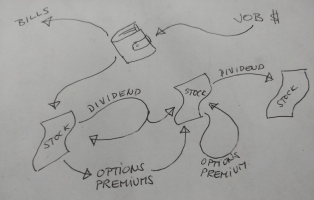I believe in trading in the stock market. So, I started my own trading business. I will be posting my progress and insights here.
I started in my "intro" but I will continue posting here.
Here is my Intro thread: INTRO - On the path
---------------------------------------------------------------------------------------------------------------------------------------------------------
► TRADING PLAN
We are investors, not traders. We buy assets - dividend-paying companies. We buy dividend growth companies. Our plan is to hold those companies forever. We treat those businesses we are buying as our businesses. It is like real estate. People do not buy homes just to sell them the next day, or next month. People buy to hold their home for the next 30 years or more. We buy dividend growth companies for the same reason.
We buy dividend growth companies to generate income receiving dividends. We want our businesses to reward us for holding their shares and paying us for it. We reinvest the dividends to accumulate more shares. Our goal in accumulating shares of a selected company is to reach 100 shares of that business. All dividends and account deposits are used to accumulate shares.
Once we accumulate 100 shares of a company, we start selling covered calls. When selling covered calls, we sell to avoid our shares being called away. We deploy all hedging strategies to avoid the exercise of the calls. If, however, our shares are called away, we immediately start selling naked or cash-secured puts. We sell puts as a means of investment to buy shares, not to speculate or sell put just to bring premiums. We sell puts against companies we want to buy. Once the shares are assigned to us, we implement the Wheel of Fortune strategy by immediately start selling covered calls again.
All premiums generated from selling covered calls or puts are used to buy more shares of the companies we want to hold.
We only sell our companies when they no longer meet our requirements - reduce or suspend the dividend.
From time to time, we use other options strategies to generate income: poor man's covered calls, butterflies, covered strangles, or collars.
Poor man's covered call
We use this strategy against expensive stocks where we do not have enough capital to trade a standard covered call right away or in the near future and when saving money would take many months or years; usually indexes such as SPY, RUT, IWM, etc. We also use it against ETFs or individual stocks while accumulating shares of that stock.
Butterfly
We use this strategy as a directional trade. When we identify a strong trend in any direction, we may apply this strategy to limit our risk but reap a decent profit. For example, buying a call against SPY to participate in a strong trend would cost us $800 while the same butterfly would cost us $200. This limits our risk in case we are wrong.
Covered strangle
This strategy is selling an OTM put and a call against a stock which we want to add shares to our holdings and we already own shares. For example, we own 100 shares of a stock XYZ, and we are OK to buy another 100 shares. We sell covered strangle and our calls are covered by the existing position we already own and our put is covered by cash we have in our account in case we get assigned.
Collars
We may use this strategy (selling covered calls and use the premium to buy protective puts) if we see a need to protect our holdings and buy insurance. The covered calls will generate income for us to buy the puts.
Cost basis offset
Selling covered calls and puts, as well as other strategies, will be used to offset our cost basis. This is more of a psychological or mental offset. However, it helps to see it as having less risk in our stock and that we have purchased our shares for "free" (we used premiums collected when selling the calls and puts, although on many occasions we started collecting these premiums after we purchased the stock).
What about other options strategies?
From time to time we may use a different options strategy, for example, naked call, if we see it fit and we are prepared for any consequences from such trades. But, these trades will be very rare.
► REDUCING TRADING COST
Our other trading goal is to reduce trading costs. Therefore we picked a broker that charges low or no fees to trade. We think Tasty Works is the right broker for us. Tasty Works charges no fees to purchase or sell stocks and approx. 1.15 per contract of options trading. This allows us to accumulate our stock holdings buying a single share of the desired stock for no fee.
► DISCLAIMER
Note that all trades presented here are our trades and we post them for educational purposes. We are not licensed as investment advisors and we do not know your objectives and goals, so we cannot provide you with any specific investment advice. If you seek advice, contact a licensed advisor. Note, that trading or investing in stocks, options, or futures involves risk and that you may lose all your money. If you decide to mirror our trades, do it at your own risk and do your own homework.▼
I started in my "intro" but I will continue posting here.
Here is my Intro thread: INTRO - On the path
---------------------------------------------------------------------------------------------------------------------------------------------------------
► TRADING PLAN
We are investors, not traders. We buy assets - dividend-paying companies. We buy dividend growth companies. Our plan is to hold those companies forever. We treat those businesses we are buying as our businesses. It is like real estate. People do not buy homes just to sell them the next day, or next month. People buy to hold their home for the next 30 years or more. We buy dividend growth companies for the same reason.
We buy dividend growth companies to generate income receiving dividends. We want our businesses to reward us for holding their shares and paying us for it. We reinvest the dividends to accumulate more shares. Our goal in accumulating shares of a selected company is to reach 100 shares of that business. All dividends and account deposits are used to accumulate shares.
Once we accumulate 100 shares of a company, we start selling covered calls. When selling covered calls, we sell to avoid our shares being called away. We deploy all hedging strategies to avoid the exercise of the calls. If, however, our shares are called away, we immediately start selling naked or cash-secured puts. We sell puts as a means of investment to buy shares, not to speculate or sell put just to bring premiums. We sell puts against companies we want to buy. Once the shares are assigned to us, we implement the Wheel of Fortune strategy by immediately start selling covered calls again.
All premiums generated from selling covered calls or puts are used to buy more shares of the companies we want to hold.
We only sell our companies when they no longer meet our requirements - reduce or suspend the dividend.
From time to time, we use other options strategies to generate income: poor man's covered calls, butterflies, covered strangles, or collars.
Poor man's covered call
We use this strategy against expensive stocks where we do not have enough capital to trade a standard covered call right away or in the near future and when saving money would take many months or years; usually indexes such as SPY, RUT, IWM, etc. We also use it against ETFs or individual stocks while accumulating shares of that stock.
Butterfly
We use this strategy as a directional trade. When we identify a strong trend in any direction, we may apply this strategy to limit our risk but reap a decent profit. For example, buying a call against SPY to participate in a strong trend would cost us $800 while the same butterfly would cost us $200. This limits our risk in case we are wrong.
Covered strangle
This strategy is selling an OTM put and a call against a stock which we want to add shares to our holdings and we already own shares. For example, we own 100 shares of a stock XYZ, and we are OK to buy another 100 shares. We sell covered strangle and our calls are covered by the existing position we already own and our put is covered by cash we have in our account in case we get assigned.
Collars
We may use this strategy (selling covered calls and use the premium to buy protective puts) if we see a need to protect our holdings and buy insurance. The covered calls will generate income for us to buy the puts.
Cost basis offset
Selling covered calls and puts, as well as other strategies, will be used to offset our cost basis. This is more of a psychological or mental offset. However, it helps to see it as having less risk in our stock and that we have purchased our shares for "free" (we used premiums collected when selling the calls and puts, although on many occasions we started collecting these premiums after we purchased the stock).
What about other options strategies?
From time to time we may use a different options strategy, for example, naked call, if we see it fit and we are prepared for any consequences from such trades. But, these trades will be very rare.
► REDUCING TRADING COST
Our other trading goal is to reduce trading costs. Therefore we picked a broker that charges low or no fees to trade. We think Tasty Works is the right broker for us. Tasty Works charges no fees to purchase or sell stocks and approx. 1.15 per contract of options trading. This allows us to accumulate our stock holdings buying a single share of the desired stock for no fee.
► DISCLAIMER
Note that all trades presented here are our trades and we post them for educational purposes. We are not licensed as investment advisors and we do not know your objectives and goals, so we cannot provide you with any specific investment advice. If you seek advice, contact a licensed advisor. Note, that trading or investing in stocks, options, or futures involves risk and that you may lose all your money. If you decide to mirror our trades, do it at your own risk and do your own homework.▼
Dislike ads? Remove them and support the forum:
Subscribe to Fastlane Insiders.



